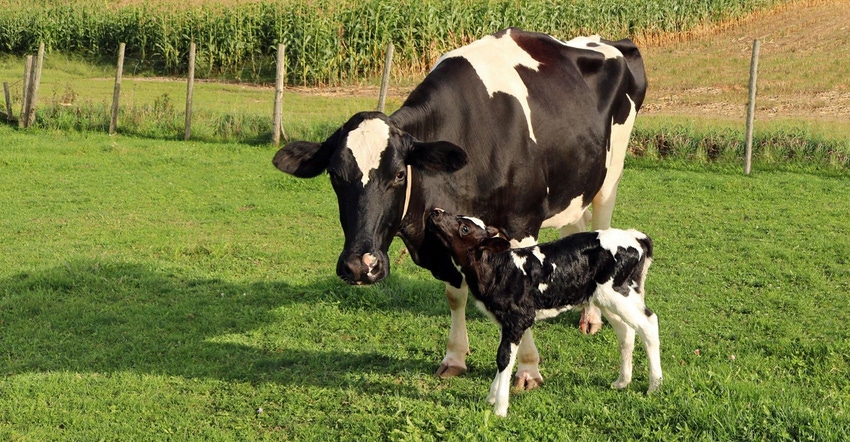August 5, 2020

What is heat stress in dairy cattle? Heat stress occurs when an environment impacts the ability of a cow to get rid of body heat. The thermoneutral zone for lactating cows is from minus 15 degrees C to 25 degrees C (5 degrees F to 77 degrees F), indicating that mature cows can handle lower temperatures better than higher temperatures.
How can you best estimate the impact of heat on your cows? A combination of environmental temperature and humidity known as the temperature-humidity index is one of the best tools to reflect the true impact of the environmental temperature on a cow. Other ways to measure heat impact are:
Rectal or vaginal temperature. This is commonly used in controlled studies.
Respiration rate. Observe flank movements; values greater than 60 breaths per minute are a threshold of heat stress.
Impact on mammary glands
Cows need to be raised in an environment where temperatures are within their thermoneutral zones to achieve their maximal genetic potential. Failure to establish adequate environmental temperature can dramatically alter behavior, health and productivity of cows.
When cows are exposed to noncooled environments, mammary epithelial cells do not proliferate well, leading to lower milk production. In heifers born to cows experiencing late-gestation heat stress, milk production potential is also reduced. So not only is the cow affected by heat stress, but her calf also stands to lose genetic potential for milk yield by being exposed to heat stress in utero. Future milk production is negatively affected by heat stress because mammary growth is impaired; thus, it is imperative to provide heat abatement strategies to improve farm profitability.
Heat stress may negatively affect the process of involution during the dry period due to endocrinological changes — reduced estrogen and increased prolactin. We know that during earlier steps of involution, many immune cells are active in the mammary gland to prepare mammary tissue for the next lactation. Successful immune function is very important to protect the mammary gland during lactating and nonlactating periods.
Some negative impacts of heat stress are:
decreased milk production in subsequent lactation
increased bulk milk somatic cell count
It is important to emphasize that heat stress is not the only factor that can negatively impact milk production and SCC during the warm season. Other factors, including reproductive strategies, and herd and nutritional management, can impact productivity on a dairy.
Heat stress and intramammary infections
Incidence rates of mastitis can increase during the warm season. Heat stress poses a negative effect on udder health, as it causes reductions in immune competence of lactating and dry cows. Immune suppression can last for a long period during the productive life of a cow and can have a detrimental impact on how cows respond to pathogen exposure. All these factors contribute to increase the probability of intramammary infections and to decrease milk quality.
Along with putting in place heat abatement strategies for your herd, you need to reduce the exposure to mastitis-causing pathogens at the teat end. To reduce risk of mastitis, follow the National Mastitis Council Recommended Mastitis Control Program.
During warm months, Trueperella pyogenes is one bacterium that can cause summer mastitis, occurring mainly in pastured cows and associated with a fly, Hydrotaea irritans. Among some clinical symptoms are swollen and painful quarters or teats and systemic signs, including fever, being off feed, depression and even death. Other characteristics with this type of mastitis are purulent lesions in quarters, and fetid and purulent milk.
Incidence of this type of mastitis can be exacerbated if farmers do not implement measures to abate heat. To prevent and control these cases, farmers need to talk to their herd veterinarians to establish appropriate mastitis treatment protocols and dry cow therapy protocols, and to implement protocols to reduce exposure to flies.
Heat stress abatement
Some strategies to reduce negative impacts of heat stress on lactating and dry cattle are:
Shade. Provide shade for cows housed on pasture or in an open lot. Each cow needs a minimum of 19 feet.
Active cooling. Use a combination of soaking cows with water and then using fans. Repeat this process throughout the day.
Remember to locate cooling strategies in areas where cows will concentrate — for example, holding pens or the feeding line in freestall barns. It is very important that the water on the cows evaporates by the time they lie on their beds. You do not want water to be transferred to beds, as that leads to potentiatial bacterial growth and exposure.
Fuenzalida has a doctorate and is the Extension agriculture educator in Dane County, Wis. Hernandez has a doctorate and is an associate professor at the University of Wisconsin-Madison in the Department of Animal and Dairy Science. This column is provided by the University of Wisconsin-Extension Dairy Team.
You May Also Like




